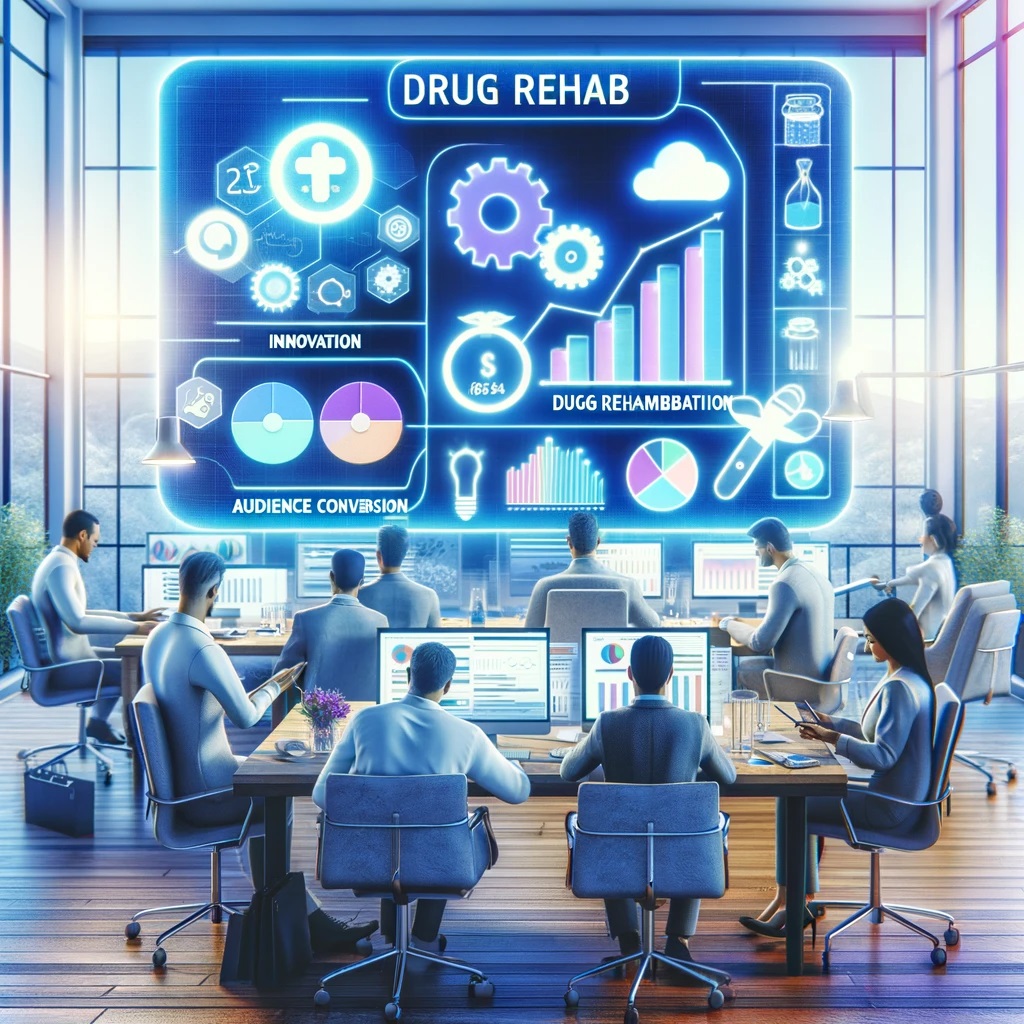
Drug Rehab Content Strategy: A Guide to Engaging and Converting Your Audience
Table of Contents
Content Marketing in Drug Rehabilitation
Introduction
The Need for a Tailored Content Strategy in Drug Rehab
The drug rehab industry faces unique challenges when it comes to content creation and marketing. With the sensitive nature of substance abuse and recovery, it becomes crucial to approach content with empathy, accuracy, and a deep understanding of the audience's journey. A bespoke content strategy is essential not just for patient acquisition but also for providing valuable support and information to those in need.
Understanding the Pillars of Effective Drug Rehab Content
Creating impactful content in the drug rehab sector hinges on several key pillars. These include trustworthiness, relevance, and personalization. By adhering to these fundamentals, content creators can establish a strong foundation for meaningful engagement with their audience.
Marketing Techniques and Patient Acquisition
Substance Abuse Marketing Techniques That Resonate
Behavioral Health Digital Advertising Fundamentals
In the realm of behavioral health, digital advertising must be approached with tact and sensitivity. It's about connecting with individuals in a way that acknowledges their struggles and offers a path to recovery. In the digital age, behavioral health marketing demands a balance of empathy and strategic acumen. For drug rehabilitation centers, the focus should be on creating campaigns that resonate on a human level, acknowledging the complexities of substance abuse. Utilizing targeted keywords, such as "narcotic rehabilitation keyword targeting" and "substance disorder SEO audit", helps in reaching the right audience. It's crucial to develop content that's not only SEO-friendly but also sensitive and informative, guiding potential patients towards recovery resources.
Drug-Free Branding Tactics and Sobriety-Focused Storytelling
Branding and storytelling that emphasize a drug-free lifestyle can inspire hope and encourage commitment to sobriety. The narratives should be authentic, relatable, and uplifting to leave a lasting impression. Sobriety-focused branding and storytelling are pivotal in drug rehab marketing. This approach involves crafting narratives that highlight the journey to a drug-free life, using motivational and relatable stories. By employing tactics like "sobriety-focused storytelling" and "drug-free branding", centers can inspire hope and demonstrate the effectiveness of their programs. Authentic stories from recovered patients, supported by evidence-based therapy content, can significantly impact audience engagement and brand credibility.
Inbound Marketing for Detox Clinics: Attracting the Right Audience
Detox Clinic Inbound Marketing Essentials
Inbound marketing for detox clinics involves crafting content that draws potential patients to your services. This content must be informative, compassionate, and optimized for search engines. Inbound marketing for detox clinics is centered around creating valuable content that attracts and retains a specific audience – those seeking detoxification services. This strategy, encompassing "detox clinic inbound marketing" and "rehab patient persona creation", focuses on understanding the needs and behaviors of potential patients and tailoring content to meet these needs. It's about building trust through educational articles, insightful blog posts, and engaging social media content, all optimized for search engines and user experience.
Recovery Program Online Engagement Tactics
Online engagement is more than just attracting clicks; it's about fostering a community and providing interactive support for those seeking help with addiction recovery. Online engagement tactics for recovery programs involve more than just a digital presence; it's about creating an interactive community. This includes "recovery program online engagement" and "therapeutic content development", where interactive tools like forums, webinars, and social media platforms are used to foster a supportive community. Engaging content, patient testimonials, and interactive sessions can provide a platform for individuals to share their experiences and find support, enhancing the online visibility of the rehab center.
Addiction Recovery Blogging as a Tool for Thought Leadership
Crafting Therapeutic Content for Recovery Blogs
Therapeutic content for recovery blogs must combine professional insights with personal experiences to guide readers through their healing journey. Blogging in the addiction recovery niche requires a unique blend of professional knowledge and compassionate communication. By focusing on "addiction recovery blogging" and "content creation for rehab centers", centers can establish themselves as thought leaders in the field. Blogs should provide a mix of scientific information, therapeutic insights, and real-life recovery stories, all written in a language that resonates with the reader's experiences and challenges.
Leveraging Recovery Storytelling for Deeper Connection
Stories of recovery can bridge the gap between clinical information and human experience, offering a powerful tool for connection and inspiration. Recovery storytelling is a powerful tool in addiction treatment marketing. It involves sharing stories of hope and success that can deeply connect with those struggling with addiction. This technique, referred to as "recovery-focused storytelling" and "mental health marketing insights", allows centers to showcase the human side of addiction and recovery, making the path to sobriety relatable and attainable. Such stories can be shared across various platforms, including blogs, social media, and video content, to widen their reach and impact.
In conclusion, the path to effective patient acquisition in drug rehabilitation requires a multifaceted approach, embracing both sensitivity and strategic digital marketing techniques. By integrating behavioral health digital advertising fundamentals with drug-free branding tactics, inbound marketing strategies for detox clinics, and thought leadership through addiction recovery blogging, rehab centers can effectively connect with and support individuals on their journey to recovery.

SEO and Online Visibility
Rehabilitation SEO Best Practices for Organic Reach
Opioid Treatment Organic Search Strategies
SEO strategies specific to opioid treatment must focus on keywords and phrases that those seeking help are most likely to use, ensuring your content is easily discoverable. Implementing effective SEO strategies for opioid treatment involves understanding the specific search behaviors and language used by the target audience. This includes optimizing for keywords and phrases commonly searched by individuals seeking help for opioid addiction. We must ensure that these keywords are seamlessly integrated into web content, articles, and blogs, making the information accessible and easy to find on search engines. Additionally, focusing on local SEO can help position the treatment services prominently in local search results, reaching those in need within the community.
Alcohol Rehab SEO Copywriting Techniques
Copywriting for alcohol rehab requires a delicate balance of SEO knowledge and understanding of the nuances of addiction and recovery. SEO copywriting for alcohol rehab is a delicate balance between using targeted keywords and providing compassionate, informative content. It involves understanding the unique challenges faced by those struggling with alcohol addiction and reflecting this understanding in the content. Utilizing terms and phrases that resonate with this audience, coupled with clear, empathetic language, can improve search engine rankings while also providing valuable information. Incorporating success stories and recovery pathways into the content can further enhance its relevance and appeal.
Advanced Rehabilitation Keyword Research
Narcotic Rehabilitation Keyword Targeting Techniques
Keyword research for narcotic rehabilitation should target not only the scientific and medical terms but also the layman's language used by those seeking information. Effective keyword research for narcotic rehabilitation involves diving into the specific language and terms used by individuals seeking help. This includes understanding both medical terminology and common vernacular used in the context of narcotic addiction. Using tools like keyword planners and analyzing search trends can help identify the most effective keywords. These keywords should be strategically placed in web content, meta tags, and headers to improve organic search visibility and reach the intended audience.
Utilizing NLP, LSI, Lemmatization, and Stemming for Enhanced SEO
Natural language processing and latent semantic indexing can significantly improve the visibility of rehab content by aligning with the ways people naturally search for information. To enhance the SEO of rehabilitation content, we must leverage advanced techniques like Natural Language Processing (NLP), Latent Semantic Indexing (LSI), lemmatization, and stemming. These techniques help in understanding the context and variations of search queries related to drug rehabilitation. By implementing these, we can create content that aligns more closely with the varied ways people search for information on addiction and treatment, thus improving the chances of ranking higher in search engine results pages (SERPs).
Maximizing Visibility with Addiction Treatment SERP Strategies
Drug Counseling Content Optimization Methods
Content optimization for drug counseling must focus on creating valuable, in-depth content that addresses the user's intent and questions. For drug counseling services, content optimization must focus on creating comprehensive, user-focused content that addresses the concerns and questions of the audience. This involves the use of relevant keywords, engaging headings, and detailed, informative content that provides real value. Incorporating multimedia elements like videos and infographics, along with accurate, updated information about drug counseling methods, can further enhance the effectiveness of the content.
Chemical Dependency Online Presence and SERP Dominance
Establishing an online presence for chemical dependency topics requires a mix of technical SEO and content that genuinely helps readers. Establishing a strong online presence for chemical dependency topics requires a strategic mix of technical SEO and meaningful content creation. This includes optimizing website speed, ensuring mobile responsiveness, and utilizing backlinks from credible sources. The content should be crafted to provide clear, informative, and supportive information to individuals seeking help, incorporating keywords and phrases that reflect the latest trends and research in the field of chemical dependency.
In conclusion, enhancing SEO and online visibility in the field of drug rehabilitation requires a deep understanding of the target audience, the utilization of advanced SEO techniques, and the creation of content that is both informative and empathetic. By implementing these strategies, rehabilitation centers can improve their organic reach, connecting more effectively with those in need of their services.

Content Development and Distribution
Creating Patient-Centered Rehab Content
Addiction Therapy Web Copy that Connects and Converts
Web copy for addiction therapy should focus on the patient's needs and the efficacy of the treatment options available, presented in a compassionate and understanding tone. Crafting web copy for addiction therapy is a delicate balance of understanding and empathy. We ensure our content is patient-focused, addressing their concerns and highlighting effective treatment options. Our approach involves:
- Empathetic Language: Using language that resonates with patients' experiences, fostering a sense of understanding and care.
- Clarity in Treatment Options: Clearly presenting the treatments available, explaining how they help in the recovery journey.
- Success Stories: Sharing real-life recovery stories to inspire hope and demonstrate the effectiveness of our programs.
- Interactive Elements: Including Q&A sections or chatbots for immediate assistance and engagement.
Holistic Addiction Treatment Marketing through Content
Content marketing for holistic addiction treatment should encompass a broad spectrum of methods and approaches, highlighting the benefits of an integrative recovery process. Our holistic approach to addiction treatment is mirrored in our content marketing:
- Diverse Methods: Showcasing a range of treatments, from traditional therapies to innovative holistic approaches.
- Educational Content: Offering insights into how holistic treatments complement traditional rehabilitation methods.
- Lifestyle Tips: Sharing content that supports a holistic lifestyle, including nutrition, exercise, and mindfulness practices.
Effective Rehabilitation Content Distribution Channels
Rehab Facility Content Distribution Networks
Identifying and utilizing the most effective content distribution networks for rehab facilities can significantly amplify your message's reach. Selecting the right channels for content distribution is critical for maximizing impact:
- Social Media Platforms: Utilizing platforms like Facebook and Instagram for wider reach and engagement.
- Email Newsletters: Regular newsletters to keep our community informed and engaged with the latest insights and success stories.
- Collaborations: Partnering with relevant influencers and websites to broaden our content's reach.
Relapse Prevention Content Outreach and Amplification
Content focused on relapse prevention needs to be shared through the right channels to reach those who can benefit most from its insights. Our relapse prevention content is crafted to provide ongoing support and guidance:
- Targeted Sharing: Distributing content through platforms frequented by our target audience, such as recovery forums and support groups.
- Interactive Webinars and Workshops: Hosting online sessions that offer practical advice and create a sense of community.
- Engagement Through Storytelling: Sharing personal journeys and expert insights to foster a deeper understanding of relapse prevention strategies.
Building a Robust Detoxification Services Content Calendar
Pharmaceutical Care Content Planning and Scheduling
A well-planned content calendar for pharmaceutical care in detoxification services ensures a consistent and timely delivery of valuable information. Our content calendar for pharmaceutical care in detoxification services is meticulously planned to ensure timely and relevant information:
- Educational Series: Regularly scheduled articles and videos explaining the role of pharmaceutical care in detoxification.
- Expert Contributions: Collaborating with healthcare professionals to provide authoritative insights.
- Consistent Updates: Keeping our audience informed with the latest developments and research in pharmaceutical care.
Substance Disorder SEO Audit to Refine Publishing Efforts
Regular SEO audits can help refine the publishing efforts for substance disorder content, keeping it relevant and visible to those in need. To ensure our content reaches those who need it most, we conduct regular SEO audits:
- Keyword Optimization: Continuously updating our content with relevant keywords to maintain high visibility in search results.
- Content Performance Analysis: Evaluating which types of content resonate most with our audience and adjusting our strategy accordingly.
- Competitive Analysis: Staying informed about industry trends and adapting our content to meet evolving needs and search engine algorithms.
In conclusion, our commitment to creating and distributing patient-centered rehab content is unwavering. We understand the power of the right words and the right channels in making a meaningful impact in the lives of those struggling with addiction.

Audience Engagement and Retention
Engaging Rehab Patient Personas with Precision
Crafting Content That Speaks to Rehab Patient Personas
Tailoring content to specific rehab patient personas requires an understanding of their unique needs, challenges, and stages in the recovery process. To effectively reach our audience, we delve deep into understanding rehab patient personas. This involves:
- Understanding Their Journey: Recognizing the stages of recovery each persona is likely in and tailoring content to their specific needs.
- Personalization: Creating content that addresses the personal struggles, questions, and aspirations of various personas.
- Engagement Strategies: Employing interactive formats like Q&As, webinars, and forums that resonate with different personas.
Addiction Treatment and Recovery Program Engagement
Engagement strategies for addiction treatment and recovery programs should foster a sense of community and ongoing support for participants. Our engagement strategy for addiction treatment and recovery programs focuses on:
- Community Building: Fostering online communities where patients can share experiences and support each other.
- Ongoing Support Content: Regularly updating our platforms with content that offers continuous guidance and motivation.
- Feedback Mechanisms: Encouraging feedback to understand our audience better and tailor programs to their evolving needs.
Leveraging Social Media Optimization in Drug Treatment
Drug Treatment Social Media Optimization Strategies
Optimizing content for social media in the drug treatment sphere can help reach a wider audience and provide an additional support network. Our social media optimization strategies are designed to maximize reach and engagement:
- Platform-Specific Content: Tailoring content to the unique environment and audience of each social platform.
- Hashtag Utilization: Using targeted hashtags to increase visibility and reach individuals seeking help.
- Engagement Analytics: Monitoring engagement metrics to refine our approach and maximize impact.
Mental Health Marketing Insights for Social Engagement
Insights into mental health marketing can inform strategies for social engagement, connecting with audiences on a deeper level through platforms they frequent. We integrate mental health marketing insights into our social engagement strategies:
- Empathetic Communication: Using language and messaging that reflects understanding and empathy.
- Resource Sharing: Providing valuable information and resources that support mental health and recovery.
- Storytelling: Sharing inspiring stories of recovery to foster hope and encourage engagement.
Evidence-Based Therapy Content for Lasting Impact
Developing Evidence-Based Therapeutic Content
Content based on evidence-based therapy practices lends credibility and can be a powerful tool for both education and engagement. Our content creation is grounded in evidence-based therapy practices:
- Research-Backed Information: Ensuring all content is based on the latest scientific research and findings in addiction treatment.
- Expert Contributions: Collaborating with healthcare professionals to provide content that is not only informative but also clinically validated.
- Relatable Scenarios: Presenting real-life scenarios and solutions that can be applied practically by our audience.
Measuring the Impact of Evidence-Based Content
Assessing the impact of evidence-based content is crucial for understanding its effectiveness and making improvements where necessary. To assess the effectiveness of our content, we implement:
- Audience Feedback Surveys: Gathering direct feedback from our readers and program participants to gauge the impact of our content.
- Engagement Metrics: Analyzing data like page views, time spent on site, and social shares to understand how our content resonates with the audience.
- Behavioral Changes: Tracking if and how our content is influencing positive behavioral changes among our audience.
In conclusion, our approach to audience engagement and retention is multifaceted and deeply rooted in understanding the unique journeys of our rehab patient personas. By leveraging social media optimization and developing evidence-based therapeutic content, we aim to create a lasting impact on those seeking help for addiction recovery.

Advanced Content Marketing Techniques
Utilizing Technology in Healthcare Marketing
NER for Substance Abuse Topics and POS Tagging in Copywriting
Named entity recognition and part-of-speech tagging can enhance the precision and relevance of copywriting for substance abuse topics. In the dynamic landscape of drug rehabilitation marketing, leveraging Named Entity Recognition (NER) and Part-Of-Speech (POS) tagging in copywriting is transformative. Here's how we do it:
- Enhancing Keyword Relevance: Using NER to identify key entities like drug names or treatment methods, ensuring content is focused and relevant.
- Contextual Understanding: POS tagging helps in understanding the context better, allowing for more nuanced and effective communication.
- Targeted Content Creation: Combining these technologies to craft content that addresses the specific concerns and needs of our audience.
Synonyms and Semantic Variations for Detoxification Services
Employing synonyms and semantic variations can improve the reach and accessibility of content related to detoxification services. To broaden the reach of our content related to detoxification services, we employ synonyms and semantic variations:
- Rich Keyword Portfolio: Incorporating a variety of keywords related to detox services to cater to different search intents.
- Semantic SEO: Leveraging semantic SEO to enhance content visibility for related searches, not just direct keyword matches.
- User-Friendly Language: Ensuring content remains accessible and understandable, even while optimizing for a range of keywords.
Amplification Techniques for Drug Rehab Content
Addiction Recovery Content Amplification Tactics
Effective amplification tactics can extend the reach of addiction recovery content, ensuring it makes an impact where it's needed most. Our approach to amplifying addiction recovery content includes:
- Multi-Channel Distribution: Spreading content across various platforms, from social media to community forums, for broader reach.
- Collaborations and Partnerships: Teaming up with influencers and organizations to share and endorse our content.
- Interactive Formats: Creating content in diverse formats, like videos or infographics, to encourage sharing and engagement.
Leveraging Content Syndication for Rehabilitation Centers
Content syndication can be a powerful tool for rehabilitation centers, allowing them to disseminate valuable information across a network of platforms. Content syndication is a key strategy for our rehabilitation centers, involving:
- Strategic Partnerships: Aligning with websites and platforms where our target audience is likely to engage with our content.
- Consistent Brand Messaging: Ensuring syndicated content aligns with our brand values and messaging for a coherent user experience.
- Measuring Effectiveness: Tracking the performance of syndicated content to gauge its impact and refine our approach.
Analytical Insights and Content Optimization
Mental Health Marketing Analytics for Content Refinement
Analytics play a crucial role in refining mental health marketing content, helping to tailor messages to audience needs and preferences. We utilize mental health marketing analytics to continuously refine our content:
- Audience Engagement Analysis: Studying which content resonates with our audience, using metrics like time on page and social shares.
- Content Personalization: Tailoring content based on user behavior and preferences gleaned from analytics.
- Trend Monitoring: Keeping tabs on emerging trends and topics in mental health to keep our content relevant and timely.
Rehabilitation Center Audience Targeting with Data-Driven Insights
Data-driven insights enable rehabilitation centers to target their audience with precision, ensuring their content strategy is both effective and efficient. Our approach to audience targeting in rehabilitation centers is data-driven:
- Creating Patient Personas: Developing detailed personas based on data to better understand and address the needs of our audience.
- Segmentation Strategies: Using insights to segment our audience and tailor content for maximum relevance and engagement.
- Feedback Loops: Implementing mechanisms for gathering and analyzing feedback to continuously adapt and personalize our content strategies.
In summary, our advanced content marketing techniques for drug rehabilitation are anchored in innovative technology use, strategic amplification, and data-driven insights. By harnessing these methods, we aim to create impactful, patient-centered content that resonates deeply with our audience, supporting their journey to recovery.
Conclusion
Summarizing Key Strategies for Drug Rehab Content Mastery
We've explored a range of strategies for creating and distributing drug rehab content that engages and converts. From SEO best practices to patient-centered copy, each approach is designed to resonate with the audience's needs and foster meaningful connections. In our journey to master drug rehab content creation, we've delved deep into various strategies, each carefully designed to connect and resonate with our audience. Here's a recap of these pivotal techniques:
- SEO Best Practices: We emphasized the importance of leveraging rehabilitation SEO best practices, ensuring our content ranks high and reaches those in need. This includes keyword optimization, understanding user intent, and creating quality backlinks.
- Patient-Centered Web Copy: Our focus on patient-centered content ensures that our messaging empathetically addresses the unique challenges and needs of individuals seeking help, fostering trust and understanding.
- Holistic Content Development: We’ve explored how therapeutic content development and sobriety-focused storytelling can create a more comprehensive and engaging narrative. This approach not only informs but also inspires and provides hope.
- Social Media and Online Engagement: Our strategy extends to drug treatment social media optimization, where we tailor content to engage meaningfully with audiences across various platforms, creating a supportive online community.
- Inbound Marketing Techniques: Utilizing inbound marketing strategies for detox clinics and rehab centers, we attract the right audience with valuable and informative content, guiding them through their journey to recovery.
- Content Distribution and Amplification: We’ve identified effective channels and methods for distributing and amplifying our content, ensuring it reaches a wider audience and has a greater impact.
- Continuous Analytics and Adaptation: By regularly performing substance disorder SEO audits and gathering mental health marketing insights, we stay informed and adapt our strategies for maximum effectiveness.
Each of these strategies plays a crucial role in creating a cohesive and impactful drug rehab content strategy that truly connects with and aids those seeking recovery.
Future Directions and Continuous Improvement in Substance Abuse Marketing
The field of drug rehab content strategy is ever-evolving. Staying abreast of the latest trends and continuously refining our approach will ensure that our content remains relevant and impactful. As the landscape of substance abuse marketing continues to evolve, it's crucial to stay ahead of the curve. Future directions and continuous improvement involve:
- Embracing New Technologies: Incorporating advanced tools like NLP, LSI, and AI in healthcare marketing to refine and personalize content strategies, making them more relevant and engaging.
- Audience Insights and Personalization: Continuously gathering and analyzing data to understand audience behavior better, leading to more targeted and personalized content strategies.
- Innovative Content Formats: Exploring diverse content formats like VR experiences or interactive tools to provide immersive and engaging ways to connect with audiences.
- Collaboration and Partnerships: Building strategic partnerships with healthcare professionals, recovery communities, and influencers to broaden our reach and impact.
- Ethical and Compliance Adherence: Staying updated with regulations and ethical standards to ensure our marketing practices remain responsible and trustworthy.
- Feedback Loops and Community Engagement: Actively seeking feedback from our audience and engaging with them to build a supportive community around our content.
Our commitment to continual learning and adaptation is essential in this ever-changing field. By staying informed about new research, trends, and audience needs, we can ensure our content remains relevant, engaging, and, most importantly, helpful for those on their journey to recovery.
In conclusion, the realm of drug rehabilitation content marketing is dynamic and requires a blend of empathy, innovation, and strategic thinking. As we continue to refine our approach and adapt to new challenges, our goal remains steadfast: to create content that not only informs but also supports and inspires those affected by addiction.
Questions You Might Ponder
How does content marketing benefit drug rehab centers?
Content marketing benefits drug rehab centers by enhancing their online visibility and establishing them as authoritative and trustworthy sources of information. Through quality content, centers can educate their audience about addiction, treatment options, and the recovery process, addressing common concerns and questions. This educational approach builds trust and rapport with potential clients and their families. Moreover, content marketing aids in SEO, driving organic traffic to the rehab center's website. It also provides material for social media engagement, increasing the center's reach and community interaction. Well-crafted content can evoke emotional responses, encourage sharing, and inspire those in need to seek help, making it a vital tool in the marketing strategy of rehab centers.
What is the importance of SEO in drug rehab content creation?
SEO is crucial in drug rehab content creation as it ensures that the valuable information provided by the centers reaches the right audience at the right time. By optimizing content with relevant keywords and phrases commonly searched by individuals seeking help for addiction, rehab centers can rank higher in search engine results, increasing the likelihood of their content being seen and accessed. SEO also involves creating user-friendly websites with quality, informative content that meets the needs of both search engines and users. This not only drives traffic but also establishes the center’s credibility and authority in addiction treatment. In a competitive online space, effective SEO can make a significant difference in a rehab center's ability to attract and help those in need.
How can storytelling be used effectively in drug rehab marketing?
Storytelling can be a powerful tool in drug rehab marketing as it humanizes the journey of addiction and recovery, making it relatable and inspiring for potential clients. Sharing success stories and testimonials of those who have gone through the rehab program can provide hope and motivation to individuals considering treatment. These stories can illustrate the effectiveness of the center’s approach, demonstrating empathy and understanding of the challenges faced in recovery. Storytelling can also be used to convey the values and philosophy of the rehab center, creating a deeper connection with the audience. By engaging emotionally with readers, storytelling can break down barriers, reduce stigma, and encourage people to take the first step towards recovery.
What are some key considerations for creating a content calendar for rehab centers?
Creating a content calendar for rehab centers requires careful planning and consideration of various factors. The content should align with key dates and awareness campaigns related to addiction and mental health, leveraging these periods for greater impact. It's important to understand the target audience and their information needs, creating content that addresses different stages of the addiction recovery journey. The calendar should also balance different types of content, including educational articles, success stories, staff profiles, and treatment program highlights, to engage a diverse audience. Consistency is key, so scheduling regular posts and updates is crucial for maintaining audience engagement. Additionally, the content should be adaptable, allowing for updates based on current trends, research findings, or changes in treatment methodologies. It's also beneficial to incorporate user-generated content, such as testimonials or community stories, to foster a sense of community and trust. Lastly, tracking the performance of content and using these insights to inform future content strategy is essential for maximizing the effectiveness of the content calendar.
How can social media be optimized for drug treatment content?
Social media optimization for drug treatment content involves tailoring content to the unique dynamics and demographics of each platform while maintaining sensitivity and compliance with healthcare communication standards. Utilizing visually appealing formats, such as infographics and short videos, can enhance engagement. Regularly posting content that educates, informs, and inspires can build a supportive online community. Engaging directly with followers through comments, messages, and interactive elements like polls or Q&A sessions can foster trust and credibility. Using relevant hashtags can increase visibility and reach a wider audience. Additionally, adhering to privacy regulations and ethical marketing practices is crucial. Monitoring and analyzing social media metrics can provide insights into audience preferences and behaviors, guiding content strategy and optimization.
What role does technology play in healthcare marketing?
Technology plays a pivotal role in healthcare marketing by enabling more targeted, efficient, and interactive communication strategies. Digital platforms allow for the collection and analysis of data to understand patient needs and behaviors, leading to more personalized marketing efforts. Advanced tools like SEO and SEM enhance online visibility and reach. Social media platforms provide avenues for direct engagement with audiences. Email marketing automation and CRM systems enable streamlined communication and follow-up. Additionally, technology facilitates the use of multimedia content, such as videos and interactive tools, enhancing user engagement and information retention. Virtual and augmented reality technologies are emerging as innovative ways to provide immersive experiences, further expanding the possibilities in healthcare marketing.
How can content be amplified to reach a larger audience in the context of addiction treatment?
Amplifying content to reach a larger audience in addiction treatment involves leveraging various digital marketing channels and strategies. Utilizing SEO techniques ensures that content appears in relevant search results. Social media platforms can be used to share and promote content, engaging with a broader audience. Collaborating with influencers or industry experts can expand reach and add credibility. Paid advertising, including PPC campaigns and social media ads, can target specific demographics. Email marketing can distribute content directly to interested individuals. Participating in online forums and community groups related to addiction and recovery can also increase visibility. Additionally, repurposing content into different formats, such as blog posts, videos, infographics, and podcasts, caters to different preferences and extends the content’s reach.
Are you ready to elevate your drug rehab content strategy with these insights? Let's collaborate to craft compelling, impactful content that makes a real difference in the lives of those seeking recovery.